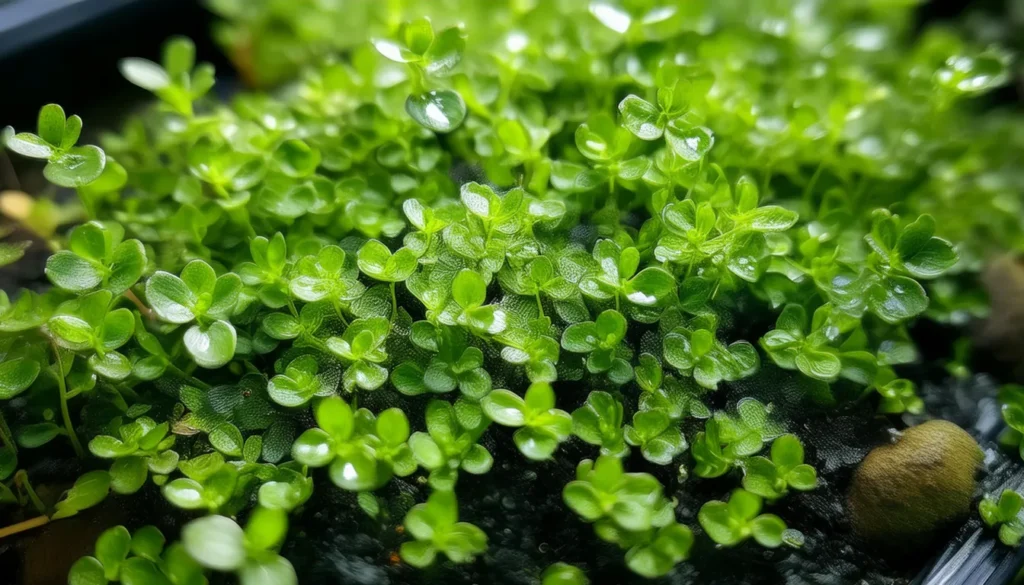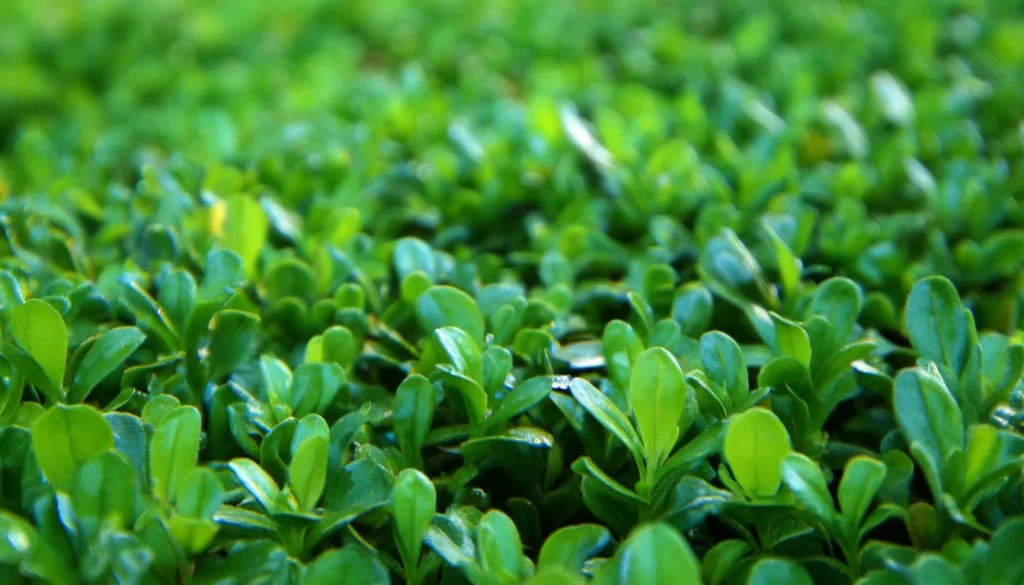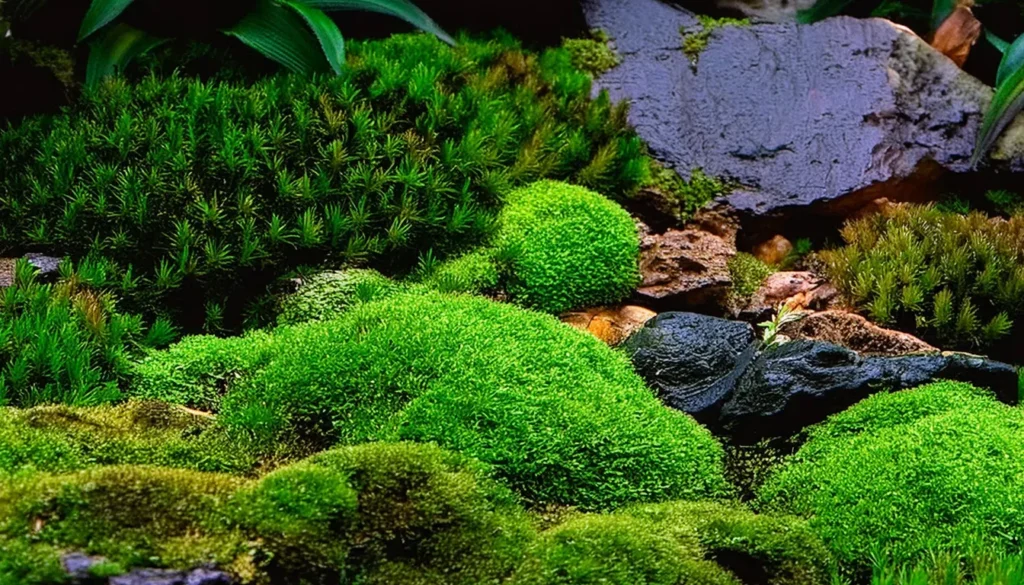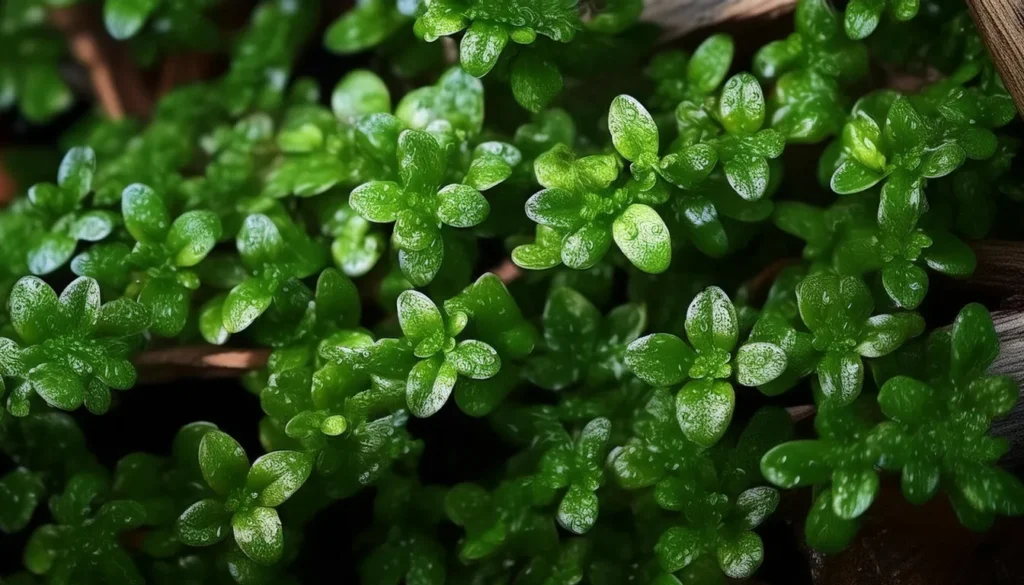Welcome to our comprehensive beginner’s guide on growing dwarf baby tears, the perfect carpeting plant for freshwater aquariums.
Whether you’re new to aquatic plant care or a seasoned enthusiast, this guide will provide all the information you need to cultivate and maintain these beautiful plants in your aquarium successfully.
Dwarf baby tears, scientifically known as Hemianthus callitrichoides, have gained immense popularity among aquarists for their lush carpet effect and vibrant green foliage.
They create a stunning visual appeal and offer numerous benefits to your freshwater aquarium, including improved water quality and providing a natural habitat for fish and invertebrates.
This guide will cover every aspect of growing dwarf baby tears, from understanding their characteristics and creating the ideal environment to mastering care techniques and ensuring long-term success. So, let’s dive in and discover the wonders of this captivating aquatic plant!

Key Takeaway
- Growing dwarf baby tears is an excellent choice for those seeking to create a lush carpet effect in their freshwater aquarium.
- These plants offer numerous benefits to the aquarium, including improved water quality and providing a natural habitat for fish and invertebrates.
- This guide will explore everything from understanding the plant’s characteristics to creating the ideal environment and mastering care techniques.
- By following the advice and tips in this guide, you can ensure the successful growth and maintenance of dwarf baby tears in your aquarium.
- Get ready to transform your aquarium into a captivating underwater landscape with the beauty of dwarf baby tears!
Quick Stats
| Attribute | Details |
| Scientific Name | Hemianthus callitrichoides |
| Common Name | Dwarf Baby Tears, HC, Cuba |
| Origin | Cuba |
| Height | 1-3 cm (0.4-1.2 inches) |
| pH Range | 5.0 – 7.0 |
| CO2 Requirement | High |
| Growth Rate | Moderate to Fast |
| Care Level | Difficult |
| Color Form | Bright green |
| Water Conditions | 22-28°C (72-82°F), soft to moderately hard water |
| Max Size | Typically remains small, forming dense carpeting |
| Lighting | High |
| Supplements | Requires nutrient-rich substrate and regular CO2 supplementation |
| Placement | Foreground |
| Propagation | Through stem cuttings or division |
What Is Dwarf Baby Tears?
Dwarf baby tears, scientifically known as Hemianthus callitrichoides, are small, delicate plants native to Cuba. They are known for their vibrant green coloration and ability to carpet freshwater aquariums’ bottoms.
These plants have gained significant popularity among aquarists due to their attractive appearance and ability to create a lush and naturalistic aquascape.
Natural Habitat And Ecology Of Dwarf Baby Tears
- Dwarf baby tears, scientifically known as Hemianthus callitrichoides, are native to the southeastern United States. They thrive in the lush, damp environments of swamps, marshes, and riverbanks. In the wild, they often carpet the ground, creating a vibrant green carpet.
- These plants have evolved to thrive in high-humidity environments with moderate to high light levels. They are found growing partially submerged, with their leaves above water and their roots anchored in the substrate. The natural habitat of dwarf baby tears provides important insights into their care requirements in the aquarium.

Scientific Classification And Characteristics
- Dwarf baby tears belong to the Plantae kingdom, Angiosperms division, Magnoliophyta class, and Asteridae subclass. They are classified within the Linderniaceae family and the Hemianthus genus. Within the Hemianthus genus, the species name for dwarf baby tears is “callitrichoides.”
- These plants are characterized by their tiny round leaves, which grow close to the substrate and form dense, lush carpets. They require high light intensity, carbon dioxide supplementation, and proper water parameters to thrive in the aquarium. Dwarf baby tears are considered to be moderately challenging plants to grow, requiring attention to detail and consistent care.
Lighting Needs Of Dwarf Baby Tears
- Lighting plays a vital role in the growth and development of dwarf baby tears. These plants require moderate to high levels of light to thrive.
- When choosing lighting for your aquarium, opt for fixtures that provide a light spectrum suitable for plant growth.
- LED lights are a popular choice among aquarists as they offer energy efficiency and customizable settings to meet the specific needs of your plants.
RELATED: Magnificence Of Echinodorus Bleheri To Enhance Your Aquascapes
Temperature Parameters
- Temperature Range: Maintain the water temperature between 68°F to 78°F (20°C to 26°C) for optimal growth of dwarf baby tears.
- Ideal Temperature: Aim for a consistent temperature around 75°F (24°C), which is within the mid-range of the recommended temperature range. This temperature provides an ideal balance between promoting growth and preventing issues like algae outbreaks.
Water Quality And Filtration
- The quality of water in your aquarium plays a vital role in the well-being of dwarf baby tears. Proper filtration and regular water changes are essential to maintain optimal water conditions.
- Aim for a temperature range of 72-82°F (22-28°C) and a pH level between 6.0 and 7.5, which mimics the natural habitat of these plants. Additionally, check ammonia, nitrate, and nitrite levels regularly to ensure they remain within safe limits.
- Using a high-quality filtration system, such as a canister filter or sponge filter, will help remove any excess nutrients or toxins that can cause issues for dwarf baby tears.
- Make sure to clean or replace filter media as the manufacturer recommends to maintain effective filtration.
Choosing The Right Substrate
- The substrate selection is crucial for the well-being of dwarf baby tears. These plants require a nutrient-rich substrate that promotes healthy growth and root development.
- Choose a substrate specifically designed for planted aquariums, such as aqua soils or nutrient-rich substrates. These substrates provide essential nutrients and create an ideal plant environment to establish a strong root system.
Placement Options
- Foreground Planting: Dwarf baby tears are commonly used as a foreground plant due to their small size and carpeting growth habit. Planting them in the foreground creates a lush carpet effect that adds depth and visual interest to the aquarium layout. Arrange them densely to achieve a thick carpet appearance.
- Rock or Driftwood Attachments: Dwarf baby tears can also be attached to rocks, driftwood, or other hardscape elements using thread or glue. This method allows for creative placement options, such as creating miniature landscapes or attaching them to vertical surfaces for a unique aquascape design.
- Between Rocks or Stones: Planting dwarf baby tears between rocks or stones can create a natural-looking carpet effect reminiscent of their growth in rocky streambeds in the wild. Ensure that the substrate is rich in nutrients and that the plants receive adequate light and CO2 for healthy growth.
- Aquascaping in Layers: Incorporate dwarf baby tears into multi-layered aquascapes by planting them in the foreground and gradually transitioning to taller plants or hardscape elements towards the back of the tank. This creates a sense of depth and perspective in the aquarium layout.

Recommended Tank Size
Creating the perfect environment for dwarf baby tears begins with selecting an appropriate tank size. These plants thrive in smaller aquariums, typically ranging from 5 to 20 gallons. The small tank size provides better control over water parameters and allows for easier maintenance.
| Tank Size | Water Temperature | pH Level | Water Hardness |
| 5-10 gallons | 72-78°F (22-25.5°C) | 6.0-7.0 | Soft to medium hardness |
| 10-20 gallons | 72-78°F (22-25.5°C) | 6.0-7.0 | Soft to medium hardness |
Suitable Tank Mates For Dwarf Baby Tears
- Small Fish Species: Choose small, peaceful fish species that won’t disturb the delicate carpeting of dwarf baby tears. Examples include small tetras like neon tetras or ember tetras, small rasboras, and dwarf or pygmy corydoras.
- Shrimp: Many aquarists successfully keep dwarf shrimp, such as cherry shrimp or crystal red shrimp, with dwarf baby tears. Shrimp help keep the tank clean by feeding on algae and detritus without damaging the plants.
- Snails: Certain snail species, such as nerite snails and Malaysian trumpet snails, can be beneficial additions to the tank. They help with algae control and substrate aeration without posing a threat to the plants.
- Small Invertebrates: Consider adding small, non-aggressive invertebrates like dwarf crayfish or small freshwater clams to complement the peaceful nature of the tank and contribute to the ecosystem.
- Bottom Dwellers: Bottom-dwelling fish species like otocinclus catfish can help keep algae in check without uprooting or damaging the dwarf baby tears.
Nutritional Needs Of The Plant
Dwarf baby tears (Hemianthus callitrichoides) require a balanced supply of both micro and macro nutrients for optimal growth:
Micro Nutrients
- Iron (Fe): Essential for chlorophyll synthesis and overall plant health. Iron deficiency can lead to yellowing of leaves.
- Manganese (Mn): Facilitates photosynthesis and enzyme activation.
- Zinc (Zn): Involved in hormone regulation and protein synthesis.
- Copper (Cu): Required for enzyme function and electron transport.
- Boron (B): Plays a role in cell wall formation and sugar transport.
- Molybdenum (Mo): Necessary for nitrogen metabolism and enzyme activation.
Macro Nutrients
- Nitrogen (N): Integral for protein synthesis, leaf growth, and overall plant vigor.
- Phosphorus (P): Important for root development, energy transfer, and flowering.
- Potassium (K): Aids in osmoregulation, enzyme activation, and overall plant health.
- Magnesium (Mg): Essential component of chlorophyll molecules and enzyme activation.
- Calcium (Ca): Important for cell wall structure and overall plant stability.
- Sulfur (S): Required for amino acid production and protein synthesis.

Cultivation
Cultivating dwarf baby tears (Hemianthus callitrichoides) requires careful preparation for growth, planting, and initial care to ensure successful establishment:
Preparation For Growth
- Ensure the aquarium is properly set up with suitable lighting and CO2 supplementation if possible, as dwarf baby tears thrive in high-light conditions with ample access to carbon dioxide.
- Create a nutrient-rich substrate layer by using nutrient-rich aquasoils or adding root tabs to ensure adequate nutrient availability for the plants.
- Ensure water parameters are within the preferred range: temperature between 68-82°F (20-28°C), pH around 6.0-7.5, and hardness of 3-8 dKH.
RELATED: The BeauCryptocoryne Spiralis Care Guide For Beginners
Planting
- Carefully divide the potted dwarf baby tears into small portions, ensuring each portion has healthy root systems attached.
- Plant the portions of dwarf baby tears into the substrate with tweezers or aquascaping tools, ensuring they are spaced evenly to allow for optimal growth and prevent overcrowding.
- Gently press the plants into the substrate to ensure they are anchored securely, but avoid burying them too deeply to prevent rotting of the stems.
Initial Care
- Maintain high lighting levels for approximately 8-10 hours per day to promote photosynthesis and healthy growth.
- Provide adequate CO2 supplementation if possible, as carbon dioxide is a crucial factor for dwarf baby tears’ growth and carpeting.
- Ensure regular fertilization with liquid fertilizers containing essential macro and micronutrients to support healthy growth.
- Monitor water parameters regularly and perform water changes as needed to maintain water quality and prevent the accumulation of excess nutrients or algae growth.
- Trim the plants regularly to promote lateral growth and prevent them from growing too tall or leggy.
Plant Propagation Tips
- Regular Trimming: Trim the tops of healthy stems regularly to encourage lateral growth and denser carpeting.
- Gentle Division: Divide healthy clumps of dwarf baby tears into smaller portions, ensuring each portion has a good root system. Replant these portions to propagate new patches.
- Floating Cuttings: Allow trimmed cuttings to float on the water’s surface for a brief period. Once roots start to develop, plant them gently into the substrate.
- Emersed Growth: Consider growing this emersed (above water) in a humid environment. This can promote faster growth and robust root development, facilitating easier propagation.
- Promote Root Growth: Ensure the substrate is nutrient-rich and conducive to root development. Gently press the stems into the substrate during planting to encourage root establishment.
- Optimal Conditions: Provide sufficient lighting, carbon dioxide supplementation (if available), and essential nutrients to support healthy growth and propagation. Monitor water parameters regularly to maintain ideal conditions.

Benefits Of Dwarf Baby Tears
- Natural Carpeting: When densely planted, it create a lush carpeting effect, adding depth and visual appeal to the aquarium. This dense carpet also provides hiding places for small fish and invertebrates, contributing to a more naturalistic habitat.
- Oxygenation: Like all aquatic plants, it contribute to oxygenation of the water through photosynthesis. Their small size and high surface area-to-volume ratio make them efficient oxygen producers, promoting a healthy aquatic environment for fish and other inhabitants.
- Water Filtration: The dense growth of this helps in water filtration by absorbing nitrates, ammonia, and other pollutants from the water. This can lead to improved water quality and reduced algae growth, creating a more stable and balanced ecosystem.
- Natural Aesthetic: The vibrant green coloration and delicate leaf structure of dwarf baby tears add a natural and refreshing aesthetic to the aquarium. Their fine foliage sways gently in the water currents, enhancing the overall beauty of the aquatic landscape.
- Environmental Enrichment: it provide shelter and foraging opportunities for small aquatic creatures, such as shrimp and fry. They also offer a natural substrate for algae growth, which serves as a food source for some fish species. This enhances the ecological diversity of the aquarium.
Design Ideas For Dwarf Baby Tears Placement
- Foreground Accent: Plant dwarf baby tears in the foreground of your aquarium to create an eye-catching focal point. The dense, lush green carpet will draw attention and add depth to your aquascape.
- Rock and Wood Integration: Combine with rocks or driftwood to create a natural and harmonious composition. The delicate foliage of the plants will beautifully contrast with the rugged texture of the rocks or the organic shapes of the wood.
- Terracing Effect: Arrange your dwarf baby tears at different heights to mimic a terracing effect. This creates a visually appealing landscape with varying layers of green, adding depth and dimension to your aquascape.
Common Challenges And Solutions
- Nutrient Deficiencies: Inadequate nutrients in the aquarium can lead to stunted growth and yellowing of the plant’s leaves. To address this issue, consider adding a comprehensive aquarium plant fertilizer that provides essential nutrients like nitrogen, phosphorus, and potassium.
- Algae Growth: Algae can quickly overtake the aquarium and compete with the nutrients and light. To control algae growth, ensure proper aquarium maintenance, including regular water changes, removing excess debris, and maintaining a consistent light duration.
- Inadequate Lighting: it require adequate lighting for photosynthesis and healthy growth. Insufficient light can lead to weak and leggy plants. Consider upgrading to a high-intensity LED light or adjusting the light duration to provide the right amount of illumination.
Conclusion
Growing this in your freshwater aquarium can be a rewarding experience. Throughout this guide, we have highlighted the key points to consider when caring for these beautiful carpeting plants.
Providing the ideal environment is crucial for the successful growth of dwarf baby tears. Understanding their natural habitat, adapting them to aquarium life, and maintaining appropriate tank size and water parameters are essential factors to consider.
Essential care, such as proper lighting, choosing the right substrate, and ensuring proper nutrition and supplementation, is vital for the health and well-being of dwarf baby tears.
Additionally, mastering plant propagation and coverage techniques will help create a lush and vibrant carpet effect in your aquarium.
Frequently Asked Question
What Sets Dwarf Baby Tears Apart From Other Carpeting Plants In Aquascaping?
It is renowned for its tiny, delicate leaves and ability to form a dense, vibrant green carpet over the aquarium substrate. Its compact size and low growth habit make it ideal for creating detailed, miniature landscapes in aquascapes.
Unlike some other carpeting plants, it demands high light levels, CO2 supplementation, and a rich nutrient substrate to thrive, which can be a rewarding challenge for dedicated aquarists.
How Can I Ensure My Dwarf Baby Tears Carpet Remains Healthy And Spreads Quickly?
To encourage rapid growth and health of this carpet, provide intense lighting, CO2 supplementation, and regular fertilization. These conditions mimic the plant’s natural environment and stimulate its growth.
Planting individual stems or small clumps into the substrate at intervals allows space for expansion and ensures each plantlet receives adequate light and nutrients. Regular trimming encourages lateral spread, leading to a denser carpet.
Can Dwarf Baby Tears Be Grown In A Tank Without Co2 Supplementation?
While it’s possible to grow it without CO2 supplementation, its growth will be significantly slower, and developing a dense carpet may be more challenging. In a non-CO2 tank, focus on optimizing conditions by ensuring strong lighting, regular liquid carbon supplements dosing, and a nutrient-rich substrate.
However, for optimal growth and health, CO2 supplementation is highly recommended.
What Are The Key Signs Of Nutrient Deficiency In Dwarf Baby Tears, And How Can I Address Them?
Nutrient deficiencies in it can manifest as yellowing leaves (nitrogen deficiency), slow growth or smaller leaves than usual (phosphorus or potassium deficiency), or pale leaves with veins that remain green (iron deficiency).
Addressing these deficiencies involves adjusting your fertilization regimen to include comprehensive liquid fertilizers that provide a balanced range of nutrients, including macro and micronutrients. Regular substrate fertilization can also support root health and growth.
How Do I Properly Trim Dwarf Baby Tears To Maintain A Lush, Dense Carpet?
Trimming this requires sharp scissors to make clean cuts without pulling up the delicate root system. Trim the top growth to maintain the desired height and density, usually about an inch or so above the substrate.
Approximately every few weeks, regular trimming encourages the plant to grow laterally, filling in gaps and creating a denser carpet. After trimming, remove the cuttings from the tank to prevent decay and maintain water quality.
Regular maintenance keeps the carpet looking its best and ensures that lower parts of the plant receive adequate light and circulation.
- Unveiling The Wonders Of Riccia Fluitans In Aquascapes - August 7, 2024
- Vallisneria Gigantea Var. Guide To Care And Cultivation At Home - July 31, 2024
- Vesicularia Dubyana Care & Growth Guide Tips For Beginner Gardeners - July 30, 2024
